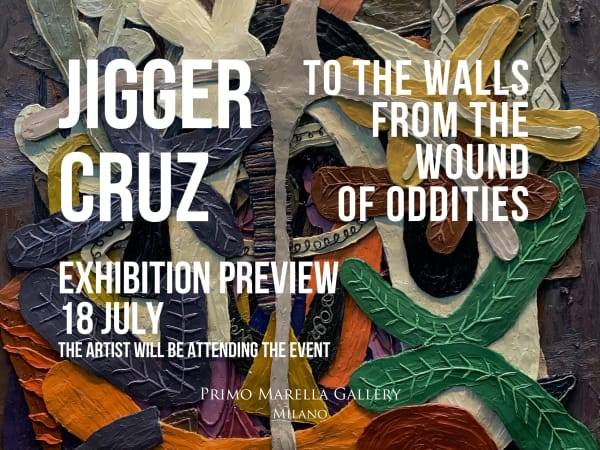Primo Marella Gallery Milano is pleased to present the new upcoming Jigger Cruz's solo exhibition "To The Walls from the Wound of Oddities"
OPENING 18 JULY at Primo Marella Gallery Milano!
Born in 1984, Manila, Philippines, he lives and works in Manila.
Jigger Cruz is a leading Filipino artist who has gained international acclaim for his tactile and sensorial paintings. Created by using techniques such as impasto, cutting, burning and spraying paint on the canvas and frames, Cruz's paintings are an investigation of the materiality of painting. At the same time, their subject matter—ranging from the burden of history to religion—addresses social and political concerns in the contemporary Philippines.
n his early works, Jigger Cruz always emphasised with importance the concept behind them, almost as if he wanted to express a revival of Filipino painting that overcame the relics left by Spanish colonialism. The latter in fact left a strong Christian and Classical/Baroque culture in the country. This was not a criticism of what happened with colonisation, it was rather the narration of a desire for a rebirth of art in the Philippines, unable to move towards an innovative, universal path, but rather anchored to its Hispanic roots.
Cruz, through his technique, succeeded in taking a very important step within the history of Filipino art: it was an overcoming of almost non-existent canons that harked back to a European past, but very different from the contemporary reality of the Philippines. Moreover, we can define Jigger as one of the main exponents of the new generation of Filipino artists with an abstract and informal matrix that has been established to date.
As of today, however, jigger Cruz's paintings are born directly with an abstract imprint through the superimposition of figures and elements rigorously formed by oil painting. This is a time- consuming procedure, especially for the stabilisation of the colour and the drying time of the oil in the various layers. In Cruz's new imagery, the forms and density of these elements are further concretised. They expand, take on increased thickness and volume, making the result of this process of dimensional overlapping similar to the genesis of a bas-relief. Just like the latter, the imprinted elements tend to emerge from the flat surface of the canvas, forming shadows, geometries and depths that recall the ancient technique. This development grants an intrinsic three-dimensionality to the abstract figures, allowing for a particularly elaborate perspective with a unique structure and texture.

